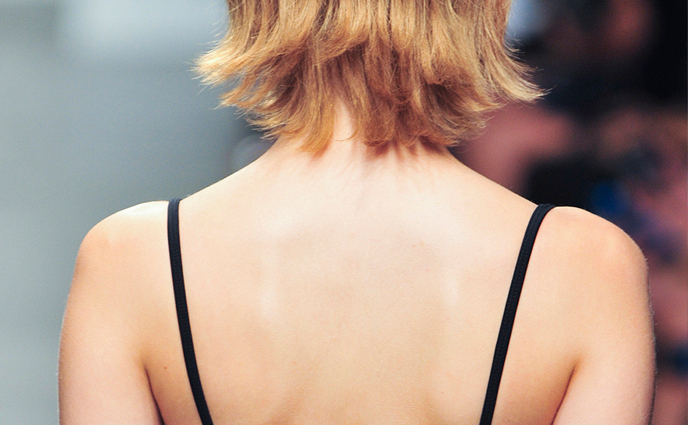Along with lasers, light treatments are one of the futuristic procedures your derm may recommend for your acne.
One is photodynamic therapy. "In photodynamic therapy, a light-activated drug called amino-levulinic acid is used in conjunction with a laser to destroy sebaceous glands that are producing too much oil," explains Peredo.
Another hot treatment is Isolaz. "It is the only system that purifies and literally drains your pores from the inside and combines vacuum and laser to help destroy acne-causing bacteria," Frank says.
Your Rx: If topical or oral medications haven't helped your acne and you've got the cash (or an insanely generous health insurance plan), look into light therapies.
One is photodynamic therapy. "In photodynamic therapy, a light-activated drug called amino-levulinic acid is used in conjunction with a laser to destroy sebaceous glands that are producing too much oil," explains Peredo.
Another hot treatment is Isolaz. "It is the only system that purifies and literally drains your pores from the inside and combines vacuum and laser to help destroy acne-causing bacteria," Frank says.
Your Rx: If topical or oral medications haven't helped your acne and you've got the cash (or an insanely generous health insurance plan), look into light therapies.
Handheld microdermabrasion tools are being released in droves, and they seem to make perfect sense for women plagued by post-acne discoloration. Our experts endorse in-office microderm treatments -- but when it comes to those at-home gadgets, proceed with caution.
"I am not a fan of microdermabrasion systems at home," Tanzi says. "The crystals, beads or particles used to scrub the skin can be very irritating, leading to increased inflammation and redness, which is not something we want in acne-prone skin."
Your Rx: Goldfaden recommends derm-administered microdermabrasion for women who have acne scars, but advises sticking to facial scrubs (like his Goldfaden MD Doctors Scrub Ruby Crystal Microderm Exfoliator) for home use. Frank recommends a gentle facial scrub or brush, a la the Clarisonic Mia.
"I am not a fan of microdermabrasion systems at home," Tanzi says. "The crystals, beads or particles used to scrub the skin can be very irritating, leading to increased inflammation and redness, which is not something we want in acne-prone skin."
Your Rx: Goldfaden recommends derm-administered microdermabrasion for women who have acne scars, but advises sticking to facial scrubs (like his Goldfaden MD Doctors Scrub Ruby Crystal Microderm Exfoliator) for home use. Frank recommends a gentle facial scrub or brush, a la the Clarisonic Mia.
If hard-to-pronounce synthetic ingredients aren't your bag, natural ingredients can be used to treat acne.
"I will always be the first to say natural is best way to go, but this is dependent on the severity of the acne," Goldfaden says. "If the skin is inflamed or infected, then a course of antibiotics should be prescribed." Start with natural products and see what happens, he suggests.
Your Rx: Three natural ingredients get a thumbs-up from our experts. Tanzi mentions tea tree oil, which is "anti-inflammatory and helps calm acne-prone skin," as well as pomegranate seed oil, a noncomedogenic ingredient with tons of antioxidant vitamins. Goldfaden recommends the anti-inflammatory mineral zinc.
"I will always be the first to say natural is best way to go, but this is dependent on the severity of the acne," Goldfaden says. "If the skin is inflamed or infected, then a course of antibiotics should be prescribed." Start with natural products and see what happens, he suggests.
Your Rx: Three natural ingredients get a thumbs-up from our experts. Tanzi mentions tea tree oil, which is "anti-inflammatory and helps calm acne-prone skin," as well as pomegranate seed oil, a noncomedogenic ingredient with tons of antioxidant vitamins. Goldfaden recommends the anti-inflammatory mineral zinc.
You've heard of antioxidants and you know they're good for your skin -- you just don't know why. Turns out they're especially good for acne-ridden folk.
Antioxidants fight oxidation, which happens when free radicals form in your body. Free radicals are molecules that have lost one of their electrons. So they borrow electrons from other molecules to become stable, causing those molecules to borrow electrons from other molecules, and so on. This molecule-mooching leads to oxidative stress, which leads to inflammation, a major cause of blemishes.
If you have a high level of antioxidants in your body, this counteracts the inflammation caused by oxidative stress. However, acne-prone people are clinically shown to have more inflammatory markers in their blood as well as lower levels of antioxidants in their systems. Essentially, if you're pimple-prone, you're probably deficient in antioxidants.
Your Rx: Use antioxidant-infused skin care products; investing in high-quality products is key, since antioxidants quickly degrade when they're not properly stabilized. Common antioxidants include vitamins A, C and E, beta carotene and resveratrol. (We love SkinCeuticals Resveratrol B E). Also make sure to eat antioxidant-rich fruits and vegetables as well as "superfoods" like chia seeds and green tea.
Antioxidants fight oxidation, which happens when free radicals form in your body. Free radicals are molecules that have lost one of their electrons. So they borrow electrons from other molecules to become stable, causing those molecules to borrow electrons from other molecules, and so on. This molecule-mooching leads to oxidative stress, which leads to inflammation, a major cause of blemishes.
If you have a high level of antioxidants in your body, this counteracts the inflammation caused by oxidative stress. However, acne-prone people are clinically shown to have more inflammatory markers in their blood as well as lower levels of antioxidants in their systems. Essentially, if you're pimple-prone, you're probably deficient in antioxidants.
Your Rx: Use antioxidant-infused skin care products; investing in high-quality products is key, since antioxidants quickly degrade when they're not properly stabilized. Common antioxidants include vitamins A, C and E, beta carotene and resveratrol. (We love SkinCeuticals Resveratrol B E). Also make sure to eat antioxidant-rich fruits and vegetables as well as "superfoods" like chia seeds and green tea.
Like birth control pills, antibiotics can be taken for several months to treat acne. Your derm will probably prescribe a "-mycin" or a "-cycline" -- that is, erythromycin, clindamycin, tetracycline, minocycline or doxycycline. They're usually prescribed in combination with topical antibiotics to clear bacteria and reduce inflammation.
Another interesting med option: spironolactone, a blood-pressure medication that's used off-label for relieving acne. Spiro is an anti-androgen, and because oil production is an androgen function, it decreases the amount of sebum in the skin, thwarting pimples.
Your Rx: Talk to your derm about whether your acne is hormonal, which can help lead you to the right prescription. "Oral antibiotics work well for people with inflammatory acne and cysts," says Tanzi. "Spironolactone works better for women with adult-onset acne that has a strong hormone component."
Another interesting med option: spironolactone, a blood-pressure medication that's used off-label for relieving acne. Spiro is an anti-androgen, and because oil production is an androgen function, it decreases the amount of sebum in the skin, thwarting pimples.
Your Rx: Talk to your derm about whether your acne is hormonal, which can help lead you to the right prescription. "Oral antibiotics work well for people with inflammatory acne and cysts," says Tanzi. "Spironolactone works better for women with adult-onset acne that has a strong hormone component."
What causes acne, how to prevent acne from forming, and how to treat existing acne are three of the most mystifying issues in dermatology today. That's because acne can be influenced by such a weird amalgamation of factors -- from major influences like lifestyle, heredity and stress down to seemingly insignificant details like what you pour over your cereal in the morning. Here's everything we know about acne and how to cure it, from the foods that cause acne to pimple home remedies to antibiotics for acne.




